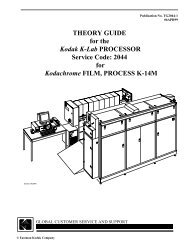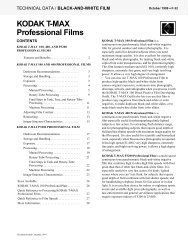F-4016 - 125px
F-4016 - 125px
F-4016 - 125px
Create successful ePaper yourself
Turn your PDF publications into a flip-book with our unique Google optimized e-Paper software.
EXPOSURE<br />
The nominal speed of KODAK PROFESSIONAL T-MAX<br />
100 Film is EI 100. It was determined in a manner published<br />
in ISO standards. Exposing the film at EI 100 should usually<br />
lead to the minimum exposure required to produce<br />
negatives of very high quality (see the following table).<br />
This film has good latitude and responds well to changes in<br />
development time. For consistent results, use the rated<br />
speed or make tests to determine a speed rating that<br />
meets your needs. For information on methods of<br />
determining your best exposure and developer<br />
combination, see KODAK Publication No. F-5, KODAK<br />
Professional Black-and-White Films.<br />
When you use T-MAX 100 Film for reversal<br />
applications, expose it at EI 50. For more information on<br />
reversal processing, see KODAK Publication No. J-87,<br />
KODAK T-MAX 100 Direct Positive Film Developing Outfit.<br />
The nominal speed of KODAK PROFESSIONAL T-MAX<br />
400 Film is EI 400. It was determined in a manner<br />
published in ISO standards. Because of its great latitude,<br />
you can underexpose this film by one stop (at EI 800) and<br />
still obtain high quality with normal development in most<br />
developers. There will be no change in the grain in the final<br />
print, but there will be a slight loss of shadow detail and a<br />
reduction in printing contrast of about one-half paper<br />
grade.<br />
When you need very high speed, you can expose<br />
T-MAX 400 Film at EI 1600 and increase the development<br />
time. With the longer development time, there will be an<br />
increase in contrast and graininess with additional loss of<br />
shadow detail, but negatives will still produce good prints.<br />
You can even expose this film at EI 3200 with a longer<br />
development time. Underexposing by three stops and<br />
using three-stop push-processing produces a further<br />
increase in contrast and graininess, and additional loss of<br />
shadow detail, but the results will be acceptable for some<br />
applications.<br />
The speed numbers for these films are expressed as<br />
Exposure Indexes (EI). Use these exposure indexes with<br />
meters or cameras marked for ISO⁄ASA or ISO⁄DIN speeds<br />
in daylight or artificial light.<br />
The developer you use to process these films affects the<br />
exposure index. Set your camera or meter (marked for<br />
ISO⁄ASA or ISO⁄DIN speeds) at the speed for your<br />
developer given in the table.<br />
Use This Exposure Index<br />
KODAK Developer or<br />
Developer and<br />
Replenisher<br />
T-MAX 100 Film T-MAX 400 Film<br />
T-MAX 100 / 21° 400 / 27°<br />
T-MAX RS 100 / 21° 400 / 27°<br />
XTOL<br />
100 / 21°<br />
400 / 27°<br />
XTOL (1:1)<br />
100 / 21°<br />
400 / 27°<br />
D-76<br />
100 / 21°<br />
400 / 27°<br />
D-76 (1:1)<br />
100 / 21°<br />
400 / 27°<br />
HC-110 (B) 100 / 21° 320 / 26°<br />
KODAK Developer or<br />
Developer and<br />
Replenisher<br />
MICRODOL-X<br />
MICRODOL-X (1:3)<br />
50 / 18°<br />
100 / 21°<br />
200 / 24°<br />
320 / 26°<br />
DURAFLO RT 80 / 20° 400 / 27°<br />
Note: The developers and exposure indexes in bold type<br />
are the primary recommendations.<br />
Under most conditions, you’ll obtain highest quality with<br />
normal exposure at the rated exposure index and normal<br />
development. For high-contrast scenes, you’ll obtain<br />
highest quality if you increase exposure by one or two<br />
stops and process the film normally.<br />
If normal development produces negatives that are<br />
consistently too low in contrast, increase the development<br />
time slightly (10 to 15 percent). If negatives are too<br />
contrasty, decrease the development time slightly (10 to<br />
15 percent). See “Adjusting Film Contrast.”<br />
If your negatives are too thin, increase exposure by using<br />
a lower exposure index; if too dense, reduce exposure by<br />
using a higher exposure index.<br />
Pushing Exposure * with KODAK PROFESSIONAL T-MAX<br />
Developer and KODAK PROFESSIONAL T-MAX RS Developer and<br />
Replenisher<br />
KODAK<br />
PROFESSIONAL<br />
Film<br />
T-MAX 100 Film<br />
T-MAX 400 Film<br />
Use This Exposure Index<br />
* Pushing exposure results in slight losses of quality compared with normal<br />
exposure and normal processing. You can also use other Kodak developers<br />
for pushing these films; however, T-MAX Developer and T-MAX RS<br />
Developer and Replenisher produce higher-quality tone reproduction (better<br />
shadow detail) under these conditions.<br />
For high-contrast scenes, such as spotlighted performers under harsh<br />
lighting, expose and process as indicated in the table. However, when detail<br />
in the deep-shadow areas is important to the scene, increase exposure by 2<br />
stops and process your film normally.<br />
† Pushing exposure and processing by 3 stops increases contrast and<br />
graininess and decreases shadow detail further. Expose and process a test roll<br />
to determine if the results are acceptable for your needs.<br />
4 KODAK PROFESSIONAL T-MAX Films • F-<strong>4016</strong><br />
1-Stop<br />
Push<br />
EI 200/24°<br />
Normal<br />
Processing<br />
EI 800/30°<br />
Normal<br />
Processing<br />
T-MAX 100 Film T-MAX 400 Film<br />
2-Stop<br />
Push<br />
EI 400/27°<br />
2-Stop Push<br />
Processing<br />
EI 1600/33°<br />
2-Stop Push<br />
Processing<br />
3-Stop<br />
Push †<br />
EI 800/30°<br />
3-Stop Push<br />
Processing<br />
EI 3200/36°<br />
3-Stop Push<br />
Processing

















